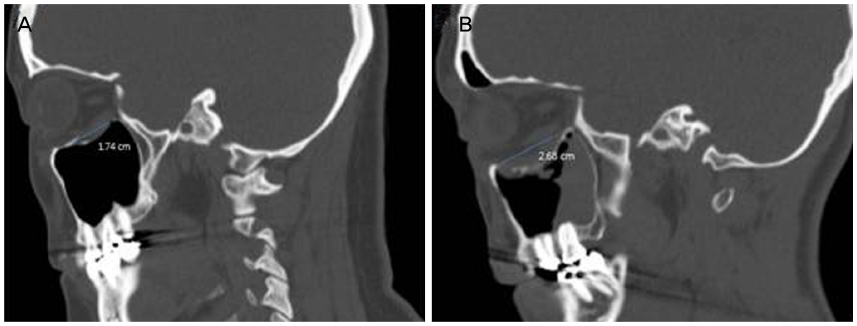J Korean Ophthalmol Soc.
2017 Jul;58(7):769-775. 10.3341/jkos.2017.58.7.769.
The Effect of Intraoperative Exophthalmometric Values on Enophthalmos Correction in Inferior Orbital Wall Reconstruction
- Affiliations
-
- 1Department of Ophthalmology, Gyeongsang National University, School of Medicine, Jinju, Korea. stramast@naver.com
- 2Department of Ophthalmology, Gyeongsang National University Changwon Hospital, Changwon, Korea.
- 3Gyeongsang Institute of Health Science, Gyeongsang National University, Jinju, Korea.
- KMID: 2387149
- DOI: http://doi.org/10.3341/jkos.2017.58.7.769
Abstract
- PURPOSE
To measure the enophthalmos corrective effect after inferior orbital wall reconstruction, we compared preoperative and intraoperative exophthalmometric values with postoperative exophthalmometric values.
METHODS
From January 2014 to April 2016, 60 eyes of 60 patients who underwent surgery for inferior orbital wall fracture were included. In Group 1, the exophthalmometric value was measured before surgery, during the operation, and 6 months after surgery using the Naugle exophthalmometer. In Group 2, the value was measured before surgery and 6 months after surgery using the Hertel exophthalmometer. The thickness of implants was determined by preoperative exophthalmometric values and overcorrection of 0.5 mm was performed in Group 1 patients with relatively large fractures.
RESULTS
The mean age of the patients was 32.4 years in Group 1 and 34.3 years in Group 2. The mean duration between injury and surgery was 4.2 weeks in Group 1 and 2.3 weeks in Group 2. There was no statistically significant difference between preoperative exophthalmometric values in Group 1 (−1.78 ± 0.31 mm) and Group 2 (−1.81 ± 0.26 mm), but postoperative exophthalmometric values between Group 1 (−0.25 ± 0.78 mm) and Group 2 (−0.53 ± 0.46 mm) were statistically different (p = 0.034).
CONCLUSIONS
The exophthalmometric values and wall fracture size are important factors for determining implant thickness of inferior orbital wall reconstruction. Intraoperative measurement of exophthalmometric values should be considered in inferior orbital wall reconstruction for enophthalmos correction.
Keyword
MeSH Terms
Figure
Reference
-
1. Hazani R, Yaremchuk M. Correction of posttraumatic enophthalmos. Arch Plast Surg. 2012; 39:11–17.2. Kim SY, Moon SH, Jang JW. Factors which influence postoperative enophthalmos in inferior orbital wall fractures. J Korean Ophthalmol Soc. 2003; 44:1489–1495.3. Manson PN, Grivas A, Rosenbaum A, et al. Studies on enophthalmos: II. The measurement of orbital injuries and their treatment by quantitative computed tomography. Plast Reconstr Surg. 1986; 77:203–214.4. Lee SJ, Park KS. Relationship between preoperative clinical features and postoperative recovery of ocular motility restriction in blow-out fractures. J Korean Ophthalmol Soc. 2001; 42:1202–1209.5. Hwang JH, Kwak MS. Residual diplopia and enophthalmos after reconstruction of orbital wall fractures. J Korean Ophthalmol Soc. 2003; 44:1959–1965.6. Kim IJ, Lee C, Cho JH. Analysis of persistent diplopia and enophthalmos after surgical repair of blower fracture. J Korean Ophthalmol Soc. 2003; 44:2204–2212.7. Yamashita M, Daizo H, Yamashita A, et al. Correction of late posttraumatic enophthalmos using an antral balloon. J Craniofac Surg. 2015; 26:1365–1369.8. Kim JS, Lee BW, Scawn RL, et al. Secondary orbital reconstruction in patients with prior orbital fracture repair. Ophthal Plast Reconstr Surg. 2016; 32:447–451.9. Clauser L, Galiè M, Pagliaro F, Tieghi R. Posttraumatic enophthalmos: etiology, principles of reconstruction, and correction. J Craniofac Surg. 2008; 19:351–359.10. Kim YH, Jung DW, Kim TG, et al. Correction of orbital wall fracture close to the optic canal using computer-assisted navigation surgery. J Craniofac Surg. 2013; 24:1118–1122.11. McNichols CH, Hatef DA, Thornton JF, et al. A paradigm shift in correcting medial orbital fracture related enophthalmos: volumetric augmentation through a lateral approach. J Craniofac Surg. 2012; 23:762–766.12. Dal Canto AJ, Linberg JV. Comparison of orbital fracture repair performed within 14 days versus 15 to 29 days after trauma. Ophthal Plast Reconstr Surg. 2008; 24:437–443.13. Beigi B, Khandwala M, Gupta D. Management of pure orbital floor fractures: a proposed protocol to prevent unnecessary or early surgery. Orbit. 2014; 33:336–342.14. Lee MS, Lew H, Lee SY. The results of delayed repair for orbital wall fracture. J Korean Ophthalmol Soc. 1998; 39:1049–1054.15. Jang KH, Kim NJ, Choung HK, Khwarg SI. Orbital wall fracture repair: the results of early and delayed surgery. J Korean Ophthalmol Soc. 2016; 57:181–187.16. Hwang JH, Lee SY, Kim SJ. Comparison of reproducibility between exophthalmometer reading measured with Hertel and Naugle exophthalmometer. J Korean Ophthalmol Soc. 1999; 40:293–298.17. Kim BJ, Kim YD. Porous polyethylene (Medpor(R)) channel implants in orbital fracture repairs. J Korean Ophthalmol Soc. 2002; 43:1238–1249.18. Jeon C, Shin JH, Woo KI, Kim YD. Porous polyethylene/titanium implants in the treatment of large orbital fractures. J Korean Ophthalmol Soc. 2009; 50:1133–1140.
- Full Text Links
- Actions
-
Cited
- CITED
-
- Close
- Share
- Similar articles
-
- The Inferior Orbital Wall Reconstruction by Titanium Micro-mesh Remodeling
- Results of Surgical Correction for Traumatic and Anophthalmic Enophthalmos
- Correction of Persistent Enophthalmos after Surgical Repair of Blow Out Fracture Using Orbital Decompression Technique of Contralateral Eye
- Transcaruncular Approach for Reconstruction of Old Medial Orbital wall Fracture
- Exophthalmometric Values With Hertel Exophthalmometers in Children



